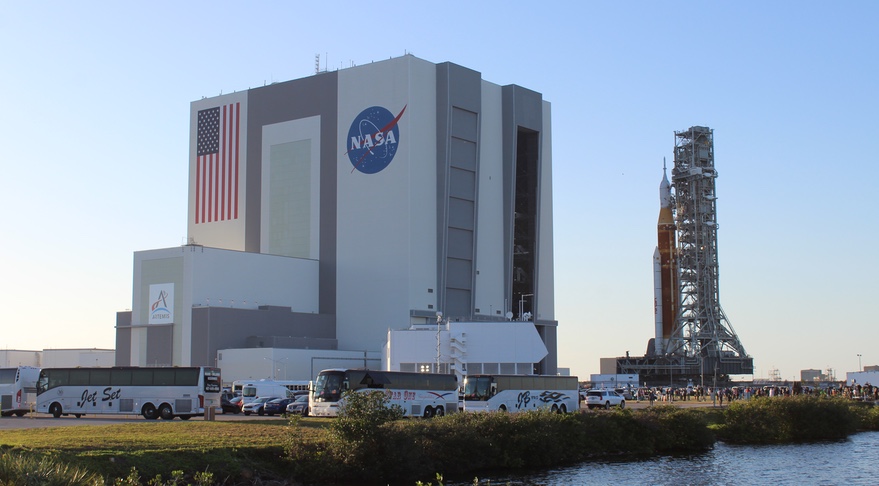KENNEDY SPACE CENTER, Fla. — A launch vehicle in development for more than a decade is now less than a day from attempting to lift off for the first time on the Artemis 1 mission.
At an Aug. 28 briefing, agency officials said launch preparations remained on track for liftoff of the Space Launch System, carrying the Orion spacecraft, at 8:33 a.m. Eastern at the beginning of a two-hour launch window. Forecasts project an 80% chance of acceptable weather at the start of the window, decreasing to 60% at the end.
Jeff Spaulding, senior NASA test director for the mission, said there were no effects from several lightning strikes at the vicinity of Launch Complex 39B the previous afternoon, including some that hit lightning protection towers surrounding the pad. “Everything to date looks good from a vehicle perspective,” he said, noting the strikes were not strong enough to warrant significant retests of systems.
The only issue teams were looking at was helium pressure in a ground system that was lower than expected, but still within requirements. Crews were scheduled to check the system and look for a possible leak later in the day. “We’re within tolerance on being able to support us for launch,” he said.
Spaulding declined to give specific odds for a launch Aug. 29. “My thoughts are that we look great for tomorrow,” he said. “I love the fact that the weather looks like it’s going to cooperate at the beginning of the window and our job is to get to the beginning of the window.”
That will mark the first time NASA has attempted to launch the SLS since the program started more than a decade ago. Congress, in a 2010 NASA authorization act, directed NASA to develop a vehicle it called the Space Launch System capable of placing at least 70 metric tons into low Earth orbit and of being enhanced later to 130 metric tons. The act set a goal of “operational capability” for the initial version of the vehicle no later than the end of 2016.
SLS, though suffered years of development delays that pushed back the first launch, originally called Exploration Mission 1 and later renamed Artemis 1. Few are better placed to reflect on those delays than the current NASA administrator, Bill Nelson, who as a senator in 2010 helped craft the authorization bill that established the SLS.
“I would simply say to you that space is hard,” Nelson said when asked about what lessons NASA learned from the SLS delays that the agency would seek to apply to future elements of the overall Artemis effort. “We are developing new systems and new technologies, and it takes money and it takes time.”
SLS, though, was billed on reusing existing shuttle-era technologies. The core stage is a version of the shuttle’s external tank with four RS-25 engines, previously flown on the shuttle orbiter, in its base. The rocket uses five-segment versions of the four-segment solid rocket boosters flown on shuttle. The current SLS upper stage, known as the Interim Cryogenic Propulsion Stage, is based on the upper stage used on United Launch Alliance’s Delta 4.
He acknowledged that the agency recognized the need to address cost and schedule overruns seen on SLS. That includes, he said, consolidating contracts as well as implementing a program office for its “Moon to Mars” effort “so we can have better coordination there.” Congress, in a NASA authorization act passed in July as part of the CHIPS Act, directed the creation of that program office to oversee the Artemis campaign, addressing concerns in Congress and from agency advisers that there was no Artemis program, in NASA’s program management structure, and no single person running it.
Nelson has previously been critical of the cost-plus contracting used for many elements of Artemis, including SLS. At a Senate hearing in May, he cited the cost and schedule overruns on Mobile Launcher 2, a launch platform for the future Block 1B version of SLS, as an example of the problems with that contracting mechanism. “There is no excuse for cost overruns, but the old way of doing business was cost-plus,” he said then. “Because of the competition we’ve been talking about, we have been moving to fixed-price where we can under procurement law.”
NASA published a pre-solicitation notice July 26 for a new contract called Exploration Production and Operations Contract (EPOC) where NASA would buy SLS launch services, rather than the rockets themselves, starting as soon as Artemis 5 in the late 2020s. The contract, which would go to a joint venture of Boeing and Northrop Grumman, is intendd to provide “a more affordable and sustainable exploration framework,” Kathy Lueuders, NASA associate administrator for space operations, said at the time.
It’s unclear how much cost savings the contract would provide. NASA’s Office of Inspector General estimated last year a single SLS launch costs NASA $2.2 billion, excluding Orion and ground systems. Lueders said last year the agency would be “really happy” to get launch and processing costs down to between $1 billion and $1.5 billion.
A successful SLS launch, though, could mitigate critiques of the cost and schedule overruns with the program. Nelson hinted at that when he mentioned at the briefing the success of the James Webb Space Telescope, which also suffered major cost and schedule problems that have been largely forgotten now that the telescope is in operation and producing stunning images and scientifically valuable data.
“We’re trying to do these things and, at the same time, do space,” he said. “The proof will be in the pudding, but right now, we’re on the cusp of something that is pretty great. You have been seeing it out there in the hopes and dreams on that pad, 39B, right now.”
